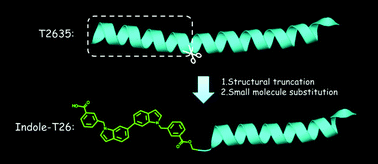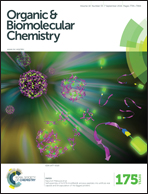An effective conjugation strategy for designing short peptide-based HIV-1 fusion inhibitors†
Abstract
Lengthy peptides corresponding to the C-terminal heptad repeat (C-peptides) of human immunodeficiency virus type 1 (HIV-1) gp41 are potent inhibitors against virus–cell fusion. Designing short C-peptide-based HIV-1 fusion inhibitors could potentially redress the physicochemical and technical liabilities of a long-peptide therapeutic. However, designing such inhibitors with high potency has been challenging. We generated a conjugated architecture by incorporating small-molecule inhibitors of gp41 into the N-terminus of a panel of truncated C-peptides. Among these small molecule-capped short peptides, the 26-residue peptide Indole-T26 inhibited HIV-1 Env-mediated cell–cell fusion and viral replication at low nanomolar levels, reaching the potency of the only clinically used 36-residue peptide T20 (enfuvirtide). Collectively, our work opens up a new avenue for developing short peptide-based HIV-1 fusion inhibitors, and may have broad applicability to the development of modulators of other class I fusion proteins.


 Please wait while we load your content...
Please wait while we load your content...